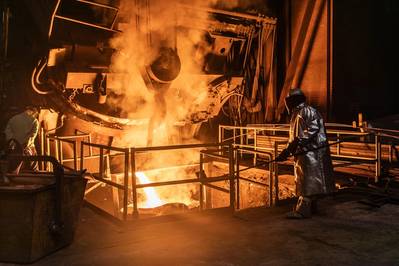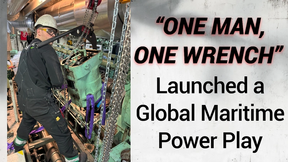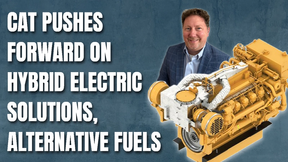Workforce Development and the Rise of the Blue-Collar Worker
For nearly 200 years, metal casting foundries have served as the backbone of American manufacturing. Though only 1,750 foundries remain today, compared to more than 6,000 in 1955, they are responsible for more than $110 billion in economic output and support nearly half a million jobs. With President Trump’s tariff negotiations underway, a renewed mandate for reshoring manufacturing efforts, and the looming decisions around the Tax Cuts and Jobs Act, the future of America’s foundries—and thus, the skilled workforce that powers them—is looking stronger than it has in decades.
A Q1 2025 survey conducted by the American Foundry Society found that manufacturers have seen a notable uptick in sales over the past 90 days and maintain a positive or somewhat positive business outlook for the remainder of the year. A key concern highlighted in the survey was the growing demand for castings, accompanied by an urgent need to increase training opportunities in metallurgy and other technical specialties related to the casting process. Notably, nearly 70% of respondents anticipate tariffs to have either a positive or neutral effect on their bottom line—an indication that momentum is shifting back toward American manufacturing.
The resurgence of skilled trades is more than anecdotal—it’s statistical. But to fully capitalize on this momentum, we must create the right legislative, economic, educational, and cultural environments to support it. How do we, as manufacturers, ensure that we attract and retain the most talented foundry managers, metallurgists, molders, melt crews, machinists, maintenance technicians, and other skilled professionals critical to our industry’s future? It starts with Americans supporting Americans.
Pass the Tax Cuts and Jobs Act—Again
According to the National Association of Manufacturers’ Q1 2025 Survey, the failure of Congress to extend the Tax Cuts and Jobs Act (TCJA) will have an immediate and significant negative effect on manufacturing.
- 69.35% of respondents said they would delay purchasing capital equipment.
- 45.23% would postpone hiring.
- 44.72% would stall plans for operational expansion.
- 41.71% would cut back on research and development.
- 40.20% would limit employee wage or benefit increases.
These numbers are not just statistics—they’re missed opportunities. Failure to act would stifle investment, innovation, and job creation. The TCJA was instrumental in reigniting domestic manufacturing after years of stagnation. Its expiration threatens to undo that progress. To attract the next generation of workers—whether on the shop floor, in the lab, or in the maintenance bay—we must provide a stable and growth-friendly policy environment that signals long-term commitment to U.S.-based industry.
Create a Company Culture Worth Committing To
Today’s skilled worker, often still referred to as "blue-collar"—a term that has increasingly become a badge of pride rather than a label of hierarchy- expects more than just a paycheck. They want to work for companies that offer a culture of respect, growth, and opportunity.
Creating such a culture means investing in competitive benefits, ongoing training, and career advancement pathways. These aren’t perks—they’re necessities for attracting and retaining top talent in an increasingly competitive labor market. And who better to lead this effort than one of the oldest industries in the country?
As the backbone of American manufacturing, foundries are among the most storied industries in our history, with many operating for over a century. That legacy wasn’t built on chance—it was built on leadership, grit, and a deep commitment to the American workforce that still exists today.
Through the Build America, Buy America Act (BABA), companies can and should demonstrate to employees that their values are more than just words. The BABA Act establishes a “Buy America Preference” for federally funded infrastructure projects, requiring that materials used in these projects be produced in the United States. For manufactured products, at least 55% of the total cost of components must be of U.S. origin, and final assembly must occur domestically. What better way to support your employees than with a fierce commitment to protecting local jobs?
When companies treat their people like long-term partners, workers are more likely to stay and help build something that lasts.
Finalize Tariffs and Level the Playing Field
It’s no secret that American manufacturers have been undercut by foreign competitors that don’t play by the same rules. The renegotiation of tariff structures is about more than fairness—it’s about survival.
As shown in recent survey data, foundries generally view tariffs favorably and anticipate a net positive impact on their business outlook. These policies incentivize domestic production, protect against unfair trade practices, and allow American companies to reinvest in their operations and workforce.
Finalizing tariff agreements sooner rather than later will provide the stability businesses need to plan strategically and invest confidently. It also sends a clear message: we’re prioritizing the American industry and the American worker.
Invest in Trade Schools and Technical Education
Another avenue worth greater emphasis is the role of trade and technical education. The Trump administration has discussed reallocating federal funding from elite institutions, especially those with large endowments, toward trade schools and workforce development programs. While controversial, the idea resonated with a growing segment of Americans who see college debt as a burden and skilled trades as a viable, and even superior, career path.
Manufacturers must echo this thinking, not just in rhetoric, but through action. Corporate investment in vocational programs, high school partnerships, and scholarship funds for technical certifications can create a talent pipeline directly into skilled trades. These programs help ensure that the next generation views manufacturing jobs not as a fallback, but as a first choice.
This isn’t just altruism—it’s good business. A more skilled, better-trained workforce directly impacts quality, output, and profitability. The sooner the private sector aligns with educational institutions, the better equipped we’ll be to meet the demands of a modern industrial economy.
Conclusion
The rise of the American skilled worker is not a fleeting trend—it’s a structural shift in how we view labor, value production, and invest in our economy. Whether we call it “blue-collar,” “skilled trades,” or simply “essential work,” what matters most is that we support it through strong policy, workplace culture, and educational opportunity. If we do that, we’re not just protecting jobs—we’re building a more resilient and self-reliant America. About the Author: Robert Shuford is the Chief Executive Officer of Mobile Pulley, a manufacturer of pumps, dredging equipment, and heavy industrial components. The company was founded in 1892 and is headquartered in Mobile, AL.
About the Author: Robert Shuford is the Chief Executive Officer of Mobile Pulley, a manufacturer of pumps, dredging equipment, and heavy industrial components. The company was founded in 1892 and is headquartered in Mobile, AL.














